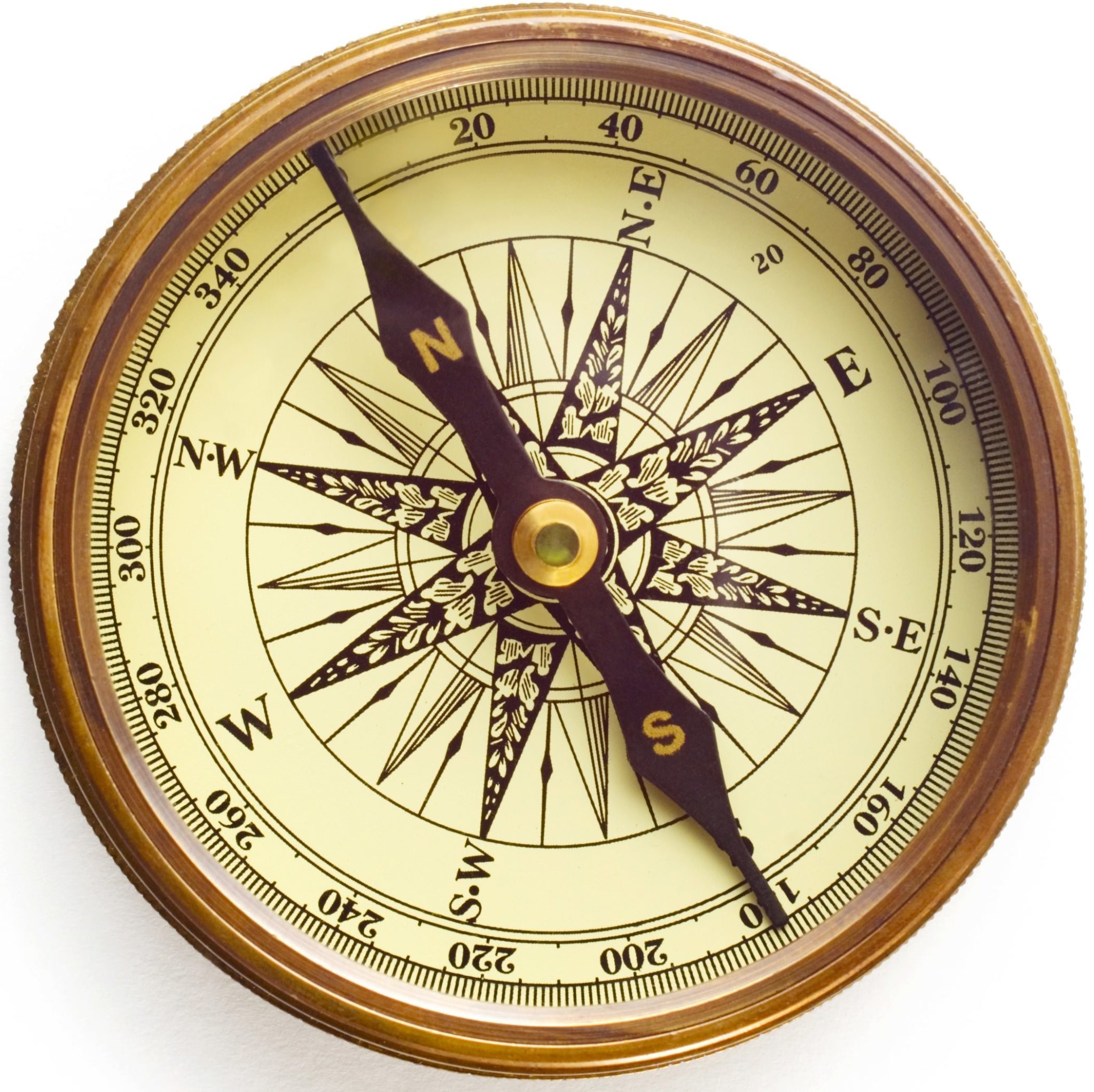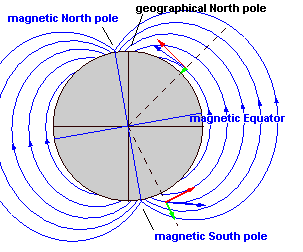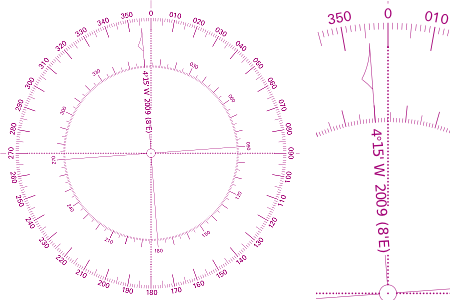The Magnetic Compass
The magnetic compass, used since ancient times to
find a way (direction) at sea, remains the primary navigation instrument
on seagoing vessels today. At the same time, the magnetic compass is also
the most dependable of on-board navigational tools. It does not need any
electric power to do its job, which is rather unusual among today's navigation
instruments.
 |
The origin of the magnetic compass is shrouded in mystery.
Certainly the Greeks knew about the attractive properties of magnetism in
ancient times. Similarly, the Chinese were aware that an iron bar
stroked with a lodestone (a naturally magnetized ore of iron) acquired a
directional North-South property as long as 2000 years ago.
Probably it was first used as a device for divination as early
as the Chinese Han Dynasty (ca. 200 BC - 200 AD), and later adopted for
navigation by the Song Dynasty during the 11th century.
Later compasses were made of suspended iron needles, magnetized by striking
them with a lodestone.
|
From China, the idea had been brought to the Middle East
region and to Europe by Arab traders.
Dry magnetic compasses of a very simple kind were certainly in use in the
Mediterranean as early as the 12th century.
However, these early compasses were not very reliable and all through the
Middle Ages, little was known about precisely how they worked.
The principle of today's magnetic compass is not different from that of the
compasses used by ancient mariners.
It consists of a long-life permanent magnetized needle, or an array of such
needles, allowed to rotate in the horizontal plane.
The superiority of present days compasses over ancient ones only result
from a better knowledge of the laws of magnetism and from greater precision
in construction.
Today's compass uses long-life permanent magnets,
with a low friction alloy pivot in a jewel bearing, to be very sensitive
to small changes in the Earth magnetic field. In the case of maritime navigation
compasses, the magnets are mounted on a compass card, which has the form
of a compass rose. This compass card floats in an optically clear oil solution
which damps the ship's motion in rough seas for a more settled reading.
Regardless of manufacturer, compasses with larger
diameter compass cards tend to be steadier and easier to read, and worth
the added price.
Terrestrial Magnetic Field
The Earth magnetic field (or geomagnetic field) is generated by electric currents induced
by convection currents of a mixture of molten iron and nickel in the Earth's outer core.
These convection currents are caused by heat escaping from the core, a natural process
called a geodynamo.
The magnetic field extends from the Earth's interior core to several tens of thousands
of kilometres into space, protecting the Earth from the charged particles of the
solar wind and cosmic rays.
A magnetic compass works because the Earth is surrounded by this huge - but weak magnetic field.
This magnetic field, causes a magnetized 'needle' of iron or steel to swing into an
approximate North-South position, if it is allowed to rotate without friction.
The north-seeking end of a compass needle is conventionally called the North Pole
(or positive pole), it must therefore be attracted to a South Pole (or negative pole).
By this convention the polarity of the magnetic North pole is actually "South",
but this is of no further practical meaning.
The Earth has two magnetic poles, which lie near the geographical North and South Poles.
However the magnetic poles do not coincide exactly with the geographical poles.
 |
For most places on the Earth, the flux lines
of magnetic field (shown in blue on the picture left) are not parallel to the Earth's
surface, but have vaying angles to the plane of the local horizon.
This angle is called Angle-of-Magnetic-Dip,(or Inclination) and it depends on the
Latitude and it increases from 0°, at the magnetic equator, to 90° at the
magnetic poles.
This is why a magnetic compass will not work well in the vicinity of the magnetic poles.
The horizontal component of the Earth magnetic force (red on the picture) becomes smaller
and the Angle-of-Magnetic-Dip is large, compared to locations with moderate Latitude.
If able to swing free in all directions without friction, the compass needle will align
to the magnetic flux lines of the Earth (provided no interference with other magnetic fields).
|
For latitudes other than the magnetic Equator, the compass needle and the compass card
will not align parallel to the plane of the horizon.
If this is not considered during the compass construction, a compass may work reliable
only for a limited range of Latitudes.
Variation
As long ago as the 15th century, mariners noticed that the
needle of a magnetic compass does not point accurately to Earth's True North.
Columbus, for instance was aware of this on his voyages across the Atlantic in the 1490s.
Instead, since the magnetic poles of the Earth do not coincide with the geographical poles,
the needle makes an angle with true North, and that angle varies from place to place
on the Earth's surface.
So there is a different magnetic variation for different places on earth.
These variations were investigated on a famous 17th century voyage by the
great scientist and astronomer Edmund Halley. It was thought at this time
that the longitude of a ship could be found by the compass variation, but
this proved to be untrue.
 The magnetic variation, results in a compass error caused by the Earth's lines of
magnetic flux deviating from the true meridians (geometrical North-South direction).
Variation depends on the actual location on the Earth.
Variation also gradually changes at a given location each year due to the
migration of the magnetic poles.
The magnetic variation, results in a compass error caused by the Earth's lines of
magnetic flux deviating from the true meridians (geometrical North-South direction).
Variation depends on the actual location on the Earth.
Variation also gradually changes at a given location each year due to the
migration of the magnetic poles.
The compass correction for variation, both the recent value as well as the annual change,
is shown on each navigation chart's compass rose.
Deviation
A compass aboard a ship is affected by the inherent magnetic field
of the ship itself.
The effect of this magnetism on the compass is called deviation.
Magnetic fields can be introduced by large pieces of metal, such as an engine, an
anchor or indeed the ship itself.
Also audio speakers as well as electrical equipment and electrical wiring may contribute
to deviation.
Since this ship-inherent magnetic field is superimposed to the Earth magnetic field,
the resulting deviation depends on the direction the ship is headed in the Earth magnetic field.
Errors in the magnetic compass from magnetic deviation can be measured and
most of it can be "compensated" or its resulting compass effect removed with small adjusting magnets.
This is a tedious task requiring some expierence, so this job of "swinging the compass" should
be done by a professional compass adjuster.
Also flux-gate compasses used as control instrument of electronic navigation equipment,
show deviation errors and must be adjusted to compensate the effect of deviation.
The remaining deviation (after compensation), which depends on the ships heading,
should be measured and documented in a Deviation Table.
This table should be used to correct the compass course and to determine the true heading.

Compass Error
Variation and deviation together pull the compass away from true North by an amount
called compass error.
By convention a compass error (deviation or variation) to the East is taken as positive value
and compass errors to the West are taken as negative values.
A variation of e.g. -3°(W) means that the compass needle (compass North) aligned to
the local magnetic flux lines, points at 357° referred to true North.
Compass courses read from this compass will be 3° higher than the true heading.
A deviation of e.g. +2° (E) means that in if the variation is 0°,
the compass North points to 002° referred to true North. Compass courses
read from this compass are 2° lower than the true heading.
The compass errors, variation and deviation are static errors.
They will not disappear even after a long period of time.
Compass errors of different nature are the transient errors,
which occur temporally and will disappear after some time. A typical
transient error occurs when the compass is moved in the Earth magnetic
field. Due to friction between the compass card and the motion-damping oil
solution in the compass, it will take some time before the compass card will
be aligned to the Earth magnetic field again after the compass was moved.
During this time the compass reading is meaningless. Additionally, the mass
of the compass card may cause some swinging of the compass card before settling
to the steady state reading again.
The transient errors are eliminated by reading
the compass only under steady state conditions of the compass card.
|


 The magnetic variation, results in a compass error caused by the Earth's lines of
magnetic flux deviating from the true meridians (geometrical North-South direction).
Variation depends on the actual location on the Earth.
Variation also gradually changes at a given location each year due to the
The magnetic variation, results in a compass error caused by the Earth's lines of
magnetic flux deviating from the true meridians (geometrical North-South direction).
Variation depends on the actual location on the Earth.
Variation also gradually changes at a given location each year due to the
